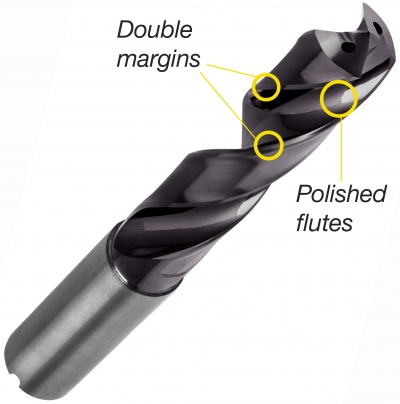
Guhring has just introduced a new drill family to the U.S.: the RT 100 XF. A new proprietary carbide grade, developed by Guhring specifically for the RT 100 XF, demonstrates the wear resistance to meet the demanding requirements of high-production machining and the durability to survive in less rigid machining conditions. The proven nano-FIREX coating has been improved by utilizing a specialized pre- and post-treatment process, which smooths out the coating.
Corner protection, achieved with a negative chamfer along the side of the cutting edge, creates an extremely tough and durable cutting edge with exceptional performance. The microgeometry honing process ensures a uniform hone resulting in a stable and efficient cutting edge.
The RT 100 XF’s concave cutting edge, relieved cone point, and microgeometry hone yield an extremely smooth surface finish. This design results in increased operating parameters and extended tool life due to the decrease in cutting forces and operating temperature.
Double margins engage immediately, resulting in improved concentricity and straightness, as well as excellent surface finish. Polished flutes improve chip evacuation, significantly reducing machining temperature, which prevents workhardening and protects the cutting edges.
RT 100 XF drills are in stock in Wisconsin, available with coolant through from 3 to 20 mm diameter and 5xD and 7xD lengths. These drills excel in steels, but can also be successfully applied in stainless steels, cast iron, titanium and nickel-base alloys and hardened steels up to 45 HRC.
Contact Details
Related Glossary Terms
- alloys
alloys
Substances having metallic properties and being composed of two or more chemical elements of which at least one is a metal.
- coolant
coolant
Fluid that reduces temperature buildup at the tool/workpiece interface during machining. Normally takes the form of a liquid such as soluble or chemical mixtures (semisynthetic, synthetic) but can be pressurized air or other gas. Because of water’s ability to absorb great quantities of heat, it is widely used as a coolant and vehicle for various cutting compounds, with the water-to-compound ratio varying with the machining task. See cutting fluid; semisynthetic cutting fluid; soluble-oil cutting fluid; synthetic cutting fluid.
- flutes
flutes
Grooves and spaces in the body of a tool that permit chip removal from, and cutting-fluid application to, the point of cut.
- stainless steels
stainless steels
Stainless steels possess high strength, heat resistance, excellent workability and erosion resistance. Four general classes have been developed to cover a range of mechanical and physical properties for particular applications. The four classes are: the austenitic types of the chromium-nickel-manganese 200 series and the chromium-nickel 300 series; the martensitic types of the chromium, hardenable 400 series; the chromium, nonhardenable 400-series ferritic types; and the precipitation-hardening type of chromium-nickel alloys with additional elements that are hardenable by solution treating and aging.
- wear resistance
wear resistance
Ability of the tool to withstand stresses that cause it to wear during cutting; an attribute linked to alloy composition, base material, thermal conditions, type of tooling and operation and other variables.
- workhardening
workhardening
Tendency of all metals to become harder when they are machined or subjected to other stresses and strains. This trait is particularly pronounced in soft, low-carbon steel or alloys containing nickel and manganese—nonmagnetic stainless steel, high-manganese steel and the superalloys Inconel and Monel.







